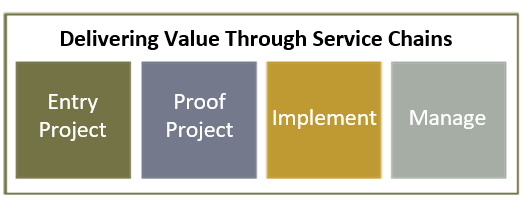This blog is part of a series on Service Chains. To read the first blog in the series, click here .
After the Proof Project, the next step in a Service ChainSM is the Implement Phase, Project, or Projects. The Implement Phase is the portion of a Service ChainSM in which the complete value of the solution is unlocked for the client by realizing the benefit, addressing the challenge, or fixing the problem. In some cases, the Manage Phase is required to fully realize the potential, but in those cases the Implement Phase fully prepares the organization to realize the promise and sets up the Manage Phase for success.
Because the Implement Phase unlocks the full value potential of a solution for a client, it is the core of a solution or Service Chain. As such, it is generally the most resource intensive for both the client and you; it also has the highest fees. In some cases (e.g. large outsourcing and hosted technology contracts), the largest fees may be derived from the Manage Phase and the Implement Phase ensures both organizations are prepared for the long-term contract.
Implement Projects can encompass a wide range of activities depending on the type of solution and could be single, multiple, or phased projects. Typical Implement Phase includes:
- “Lift and Shift” transition
- Business process transformation
- Phased development
- Pilot driven roll-outs
- Combination phased development and pilots
Many services companies already have the capabilities for Implement Projects developed and in place before adopting a Service ChainSM methodology, as it often it involves deployment of the core product or service to be pulled through; therefore, emphasis is on:
(1) getting here faster
(2) with client expectations properly set
(3) the product or service correctly priced
(4) implementation de-risked (for both parties)
Successful Implement Projects have the following characteristics:
- Fees and organizational time/disruption commensurate with the value to be achieved through the idea, although the specific time to deliver and fees depend on the scope, number of phases, etc.
- Effective change management and rigorous project/program management
- Dealing rapidly with barriers to progress
- Participation from key stakeholders for future purchase decisions (i.e., the Manage Phase and other offerings). This objective should be explicitly planned for and effective use of the Steering Committee can accomplish this goal
- Expanding participation to other influencers within the organization to build rapport and credibility
- Deliverables that make the next steps (i.e., Manage Phase) self-evident and an easy decision to buy to sustain and enhance the value achieved
- Using the access to the client’s organization to identify other opportunities
Some of the most common failure points include:
- Losing focus on the value and outcomes
- Lack of flexibility in adjusting the standard activities to unique client circumstance – i.e., an overreliance on “that’s the way we do it”
- Failure to guide and advise the client as an expert on their business processes and objectives, rather than technical aspects of the solution
As mentioned in an earlier post, some Service ChainsSM end with the Implement Phase; however, if your strategy includes managed services or long-term contracts, a Manage Phase follows. “Pure advisory” Service ChainsSM can, and when possible, should also include a Managed Phase that keeps you involved in the success of the client and generates recurring revenue. We’ll discuss this further in the next post.
To read the next blog in this series, click here.
Written by: Doug Long
About the Author: Doug Long is a Partner with McMann & Ransford and has more than 26 years of experience in consulting across various industries, topics, and client challenges. Prior firms include Deloitte and GE. He currently leads our Healthcare Practice.

